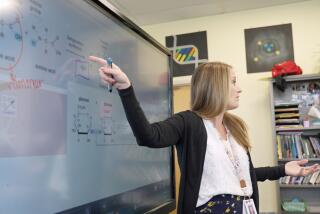Reading shouldn’t be a numbers game
School has started. I can tell because frazzled parents drag their embarrassed children up to the reference desk at my library to ask, “Where are the fifth-grade books? We need a 5.6 level that’s worth at least 7 points.”
I avoid frustrating both parties with an explanation of how the Dewey decimal system works, and ask the child, “What do you like to read?” The response from both adult and child is all too often a blank expression.
Although I am elated that many families are visiting my public library more frequently because schools send them, I am disturbed at how infrequently parents and teachers are allowing young readers to choose what to read.
During the summer, children were excited about reading because, freed from school requirements, they decided what to read. Being able to choose their favorite author, genre or topic seemed to empower them to read more. Now with school back in session, finding a book again involves navigating through a labyrinth of point values and reading levels.
How did it come to this?
More than 50 years ago, educators nationwide created complicated mathematical formulas to identify a text’s reading level. Some of these formulas were originally used to develop science textbooks that could be more easily understood by young students. Today, there are more than 200 readability formulas. Computers make using these formulas convenient for schools to apply them to literature. But mathematical readability formulas are still limited to merely counting the number of words and syllables. They are not advanced enough to measure language complexity or content.
In 2001, California started assigning reading levels to every public school student, grades 2 to 11. The state matches results from the annual Stanford 9 test to the Lexile Reading Framework and assigns each child a California Reading List number. Some schools also purchase optional programs such as Accelerated Reader and Reading Counts. The idea is to assist parents and students in selecting books tailored to match the level of each student.
However, these programs and their measurements are restrictive and confusing. For example, the California Reading List book selections, each given a Lexile number, are mostly older titles that are no longer in print.
Another problem is that the programs assign different numbers to the same book. “The Magician’s Nephew” from the Narnia series by C.S. Lewis, for example, is a 790 Lexile level, a 5.6 Reading Counts level and a 5.4 Accelerated Reader level. “The Lion, the Witch and the Wardrobe,” the next book in the series, is listed as 940 Lexile, 6.1 Reading Counts and 5.7 AR. The guidelines could prohibit a child who enjoyed the first novel from reading its sequel because of the conflicting reading levels.
If this weren’t complicated enough, the optional reading programs award incentive points for reading and successfully completing a book’s corresponding electronic quiz. And because schools have spent a lot of money on these programs, teachers often push students to participate. The most damaging consequence of this practice is when teachers require all students to earn a certain number of points as part of their reading grade. This increasingly ubiquitous approach results in students reading a book based solely on the number of points its quiz is worth.
Reading is supposed to be a pleasurable habit. California’s reading scores have remained flat since 1971. Research verifies that comprehension and reading test scores improve when students simply read more. So let’s encourage reading by allowing kids to choose what to read, unimpeded by the pressure of points, levels and quizzes.
More to Read
Sign up for our Book Club newsletter
Get the latest news, events and more from the Los Angeles Times Book Club, and help us get L.A. reading and talking.
You may occasionally receive promotional content from the Los Angeles Times.







